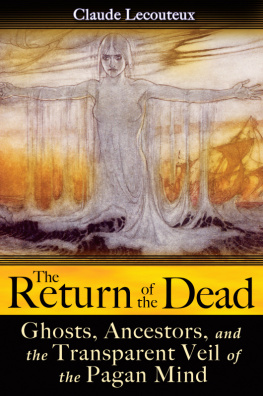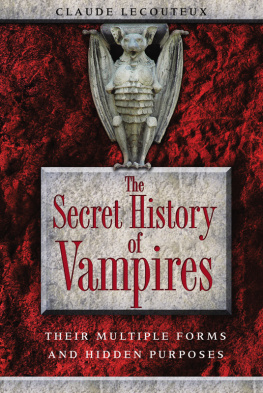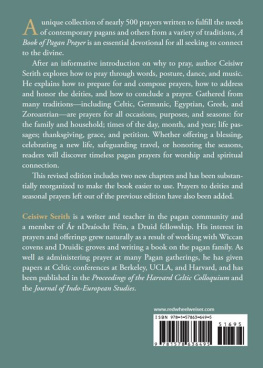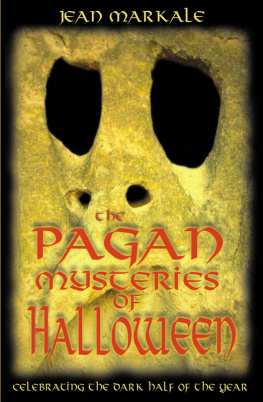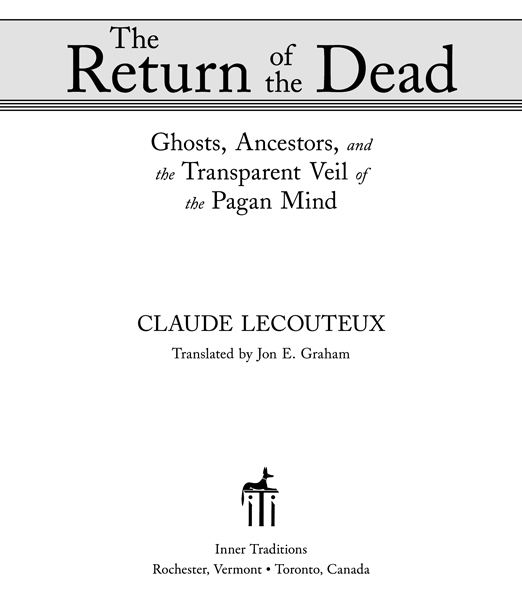
Contents

Preface

A Brief Overview of the Research
Since the publication of the first edition of this book, research has been ongoing in search of a complete definition for this complex belief system at whose heart reside the fundamental beliefs touching upon the soul, the beyond, and ancestor worship. The universal nature of the belief in a multiple soul has been confirmed by Rgis Boyer,
Ethnologists and folklorists have been especially active. The life led by the dead in tombs and the deceased who return and carry off the living or who deliver messages have been cited by Gerda Grober-Glck, Leander Petzold, and the historian Arnold Angenendt.
Before going on, I must correct an oversight: anyone interested in the survival of the beliefs examined here will find substantial parallels and information in the catalog of stories on the dead by Ingeborg Mller and Lutz Rhrich,
I should also point out another path for further research: in the iconography, revenants are often diaphanous or white in color, whereas in the texts they are often black. This reversal might be explained by the desire to distinguish them from demons but does not correspond with ancient beliefs as expressed in the testimony of Tacitus, who said a Germanic people painted their bodies black and carried shields of the same color and spread terror by passing for an army of ghosts, umbra feralis exercitus (Germania 43). Black often remains the color of the otherworld in medieval romances, whether or not this otherworld is magical or deadly.
Since 1986 it has been possible to observe that these singular dead beings can be encountered everywhere, provided we know how to recognize them beneath their various disguises. which allows us to explain the corporeal nature of the revenants, the fundamental opposition between them and intangible ghosts. What survives, and comes back, and manifests itself was clearly what the ancient Scandinavians called the hamir and what other people designate by the term alter ego. This hamir, in short, is the Double of the individual, something that brings us back to extremely widespread beliefs among the shamanic peoples and that, until now, could not be understood by those who restricted their search to the writings of the Roman world because it was impossible to read in strongly Christianized remnants.
The belief in the Double remains foreign to many researchers, the best example of which would be Claude Carozzi, who, in an otherwise excellent study of the journey into the beyond,.)
I was criticized for not examining the Infernal Hunt, also known as Mesnie Hellequin, the band of revenants who makes an appearance on certain dates. This extremely complex subject merits its own detailed study, one on which Ive been laboring for many years. In 1986 my investigations had not advanced sufficiently to offer a pertinent analysis. At my disposal I had a body of textsone that has grown non-stop since that timeand relatively ancient monographs based on false premises, as I was able to determine, which has created a good many errors.
Other critics, unfamiliar with the texts and ignorant of the research performed by scholars of northern Europe, could not grasp the mentality capable of producing all these stories about ghosts and revenants. In response to their objections, I translated and published a part of this corpus, leaving to the texts themselves the task of convincing the skeptics. Some critics also expressed the wish that I would have examined other historical periods and civilizations, but interdisciplinarity has its limits. The medievalist works on a period spanning eight centuries and the texts from the entire medieval West. The vast range of reading and study from this broad time period and many places forbids incursions into areas that are not the medievalists proper territory.
Others clearly saw the coherence of the complex; they carried water to my mill through constructive criticism and inspired further research in this subject area. I offer them my heartiest thanks for their interest and support. Finally, I want to underscore the fact that no study has emerged to invalidate my conclusions, which have been confirmed by the thesis of K. T. Nilssen.
Additional Notes
Page 19: Among the magic formulas intended to keep a dead individual in his tomb and to protect him, this one was discovered on the rune stone of Gorlev (Denmark), dating from around 900 CE:
Thjodvi raised this stone for Odinkar
F u a r k n i a s t b l m r
Enjoy your tomb!
m k i i i s s t t i i l l l
I have arranged the runes as they should be.
Gunni. Armund
Another stone found in Ledberg, in Ostrogothia (Sweden), presents the formula in this form:
m k : i i i: s s s : t t t: i i i: l l l
This has been deciphered as: thistl (l), thistle, mistil (l) mistletoe, and kistil (l), coffin, with no reason discovered for this grouping. The second line of the Gorlev inscription is nothing other than the runic alphabet. It is common knowledge that the people of an earlier time lent magic virtues to this alphabet, and Christians carved it on the steeples of churches.
Pages 3234: Putting shoes on the feet of the dead seems to have been more widespread than previously thought and not limited to Germany alone. Indeed, in the thirteenth century William Durand, bishop of Mende, notes in his Rationale divinum officiorum that many people say that the dead must wear trousers and shoes with laces, thinking that thereby they will be ready for the Last Judgment. We can assume that these shoes occupied an important place in ancient beliefs and that medieval testimonies like that of William Durand are their final echo.
Pages 3235: In her study on the shroud, Danile Alexandre-Bidon reminds us that crosses, which were almost always Latin in the fourteenth and fifteenth centuries, were always tacked to the lengthwise seam of the shroud or else placed on the forehead or, in the early Middle Ages, on the chest. She thinks that these crosses were material records of the placement of the anointment and wonders about their role in the protection of the body. In my opinion, the shroud, sanctified by the cross, possesses an apotropaic function. For the church, it was a matter of protecting the body from demonic incursions. We know in fact that one of the clerical explanations for revenants is the possession of the corpse by a devil that has slipped into and animated it. Furthermore, the individual crosses that sometimes appear on tombs lend themselves to the same analysis, as is noted by William Durand, bishop of Mende from 1285 until his death in Rome in 1296: [T]he devil greatly dreads this sign and fears to approach the place that gleams with the sign of the cross. Yet we are able to make out another function of the cross: it prevents the deceased from leaving his grave. In this sense, the crosses on the shroud possess exactly the same virtues as iron needles.
Pages 6768: The belief in the life of the dead in the tomb is confirmed clearly by a passage in the Life of Saint Fridolin, which had been inserted in the ancient Vita during the thirteenth century. The following events are supposed to have occurred during the sixth or seventh century.
The lands of Glaris (Switzerland) belonged to two brothers, Landolf and Urso. With the consent of his brother, the latter bequeathed his own lands to the cloister of Sckingen. Upon Ursos death, Landolf took back this donation. The abbot Fridolin took him before the court of Rankweil. The judges instructed him to present Urso before the court to give testimony about the gift.
Next page
